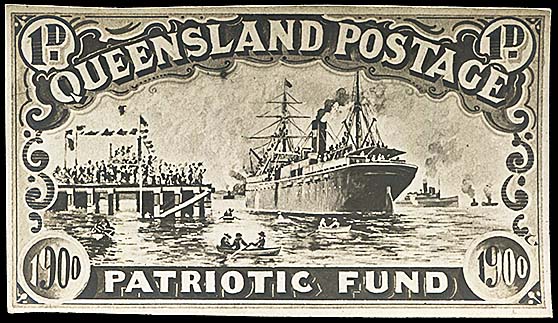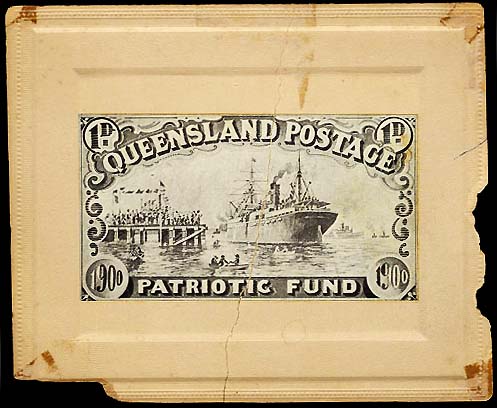The Queenslander (Brisbane) of 28 April 1900 carried the announcement that the Cabinet had approved of the issue by the Postal Department of a limited number of stamps in aid of the Patriotic Fund.
The order of presentation below is:
- the three surviving watercolour Essays;
- photographic essays showing a 1d denomination;
- photographic essays showing a 2d denomination;
- composite essays/die proofs;
Fred Elliott, of the Queensland Government Printing Office, prepared seven essays in watercolours showing possible designs for 1d and 2d stamps. Only three of these essays still exist.
The artist's hand drawings were painted in various colours on white board. On the reverse side of the Queen Victoria 1d design is a rectangle anticipating the final size of the stamp and initialled JBC with a date of 4.5.00.
Queen Victoria Essay.
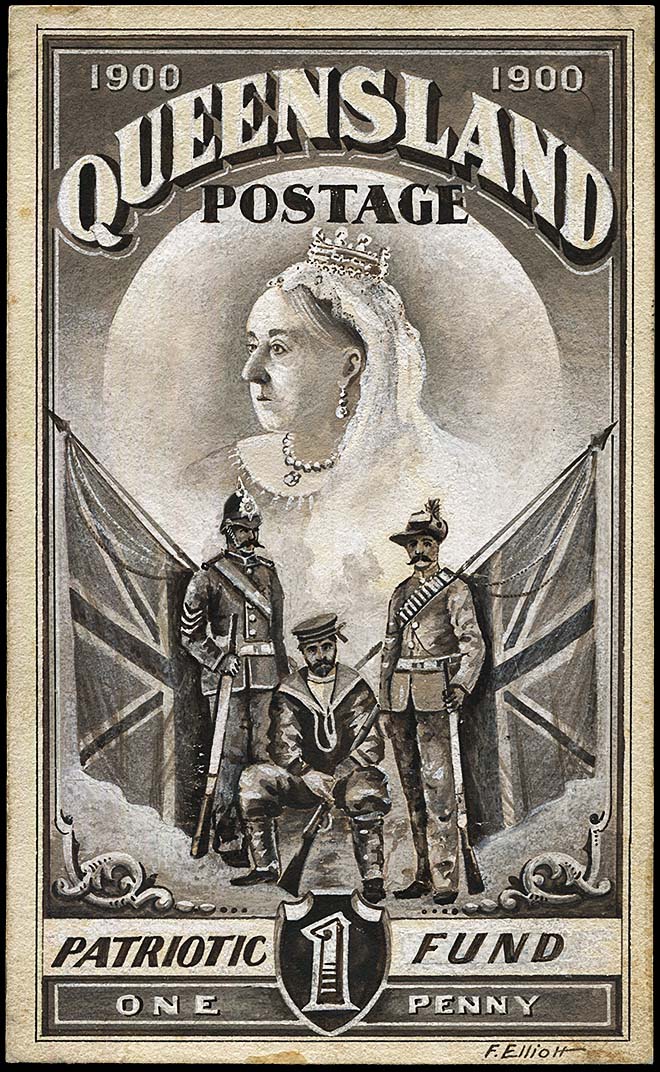 Corinphila Besaçon Auction, May 2018, Lot 3194. Corinphila Besaçon Auction, May 2018, Lot 3194. |
A partially accepted essay by Elliott for the 1d (6d) denomination.
The picture of the Queen's head is in a slightly shaded circle below the heading. Beneath this image are two Union Jacks, between which stand an Imperial Infantry Sergeant (left) a blue-jacket and a Queensland Mounted Infantryman (right). All three hold rifles. Around the sides is flower work and on the bottom "Patriotic Fund," with the figure denoting the amount of the stamp separating the two words.
|
J. B. Cooke had beeen the Government Stamp Printer for South Australia from 1881. During that time, he introduced the monogram JBC at the bottom of sheets of stamps printed under his supervision. Cooke was appointed as the first Commonwealth Stamp Printer soon after Federation but he did not move to Melbourne to establish the Stamp Printing Branch under the Commonwealth Treasury until 1909. From 1902, the stamps of Tasmania and Western Australia were printed at the Victoriam Government Printing Office.
|
From 1902 to 1908, the Queensland State Government Printer was George Arthur Vaughan. He had joined the Government soon after his arrival from England in 1881. In 1903, the Queensland Commonwealth issue was printed by the Victorian Government Printer in Melbourne.
It is unclear therefore as to why Cooke might have been involved with the design process.
Battlefield Essay.
 |
An unaccepted essay by Elliott for the 1d (6d) denomination. The stamp depicts the engagement of the Queensland Mounted Infantry at Sunnyside, Cape Colony in late December 1899. The Queenslanders figured very prominently.
Corinphila Besaçon Auction, May 2018, Lot 3193. |
Queen Victoria with separate images of soldiers on each side.
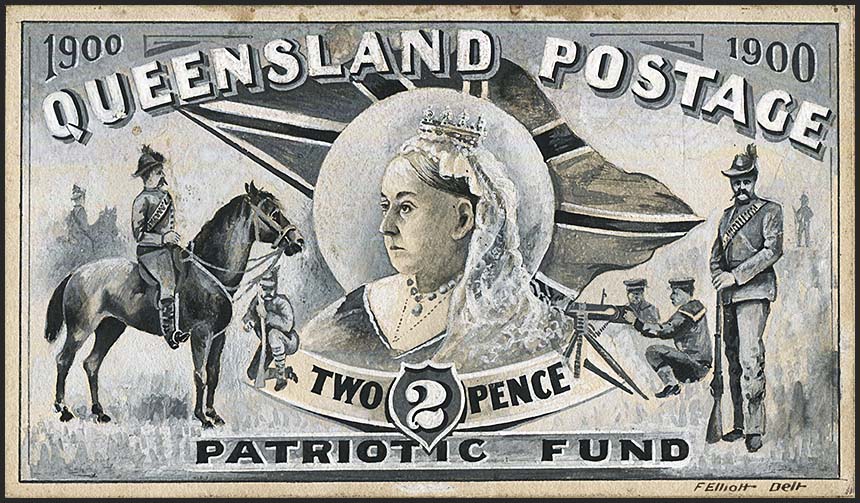 |
An unaccepted essay by Elliott for the 2d (1/-) denomination. The stamp depicts Queen Victoria wearing a crown in the centre. A mounted soldier is at the left and an infantryman and two machine gunners at the left. The design probably formed a basis for the final version.
ACE Stamp Auction November 2021, Lot 1762. |
The Photographic Essays and Plate Proofs.
The seven designs were submitted to Cabinet about the middle of April 1900 and two designs were selected for further development. Elliott's essays were then printed photographically on thin card and retouched in Indian ink and Chinese white. Each essay consisted of several aspects - all of which were considered when developing the final designs. The newspaper described the designs (see the captions below) and added "it is gratifying to find that we have an artist capable of such work. The larger drawings are remarkably fine, and the stamp-size pictures also show up well. If the stamps come out in the same way, the department will be well satisfied".
For most of the photographic essays, only one example has been recorded. For the 1d design featuring the troop ship, three examples are known (although one example is badly damaged).
There are two known plate proofs each featuring three essay designs. In the second composite shown below, the central design is unknown in the normal size for a photographic essay.
The descriptions below include comments from The Queenslander and Scudder (2013, 334-6).
The first six photographic essays below were listed in:
- Status Auctions July 2007 Lot 1688;
- Millennium Auctions Rarities sale of October 2009, Lot 352.
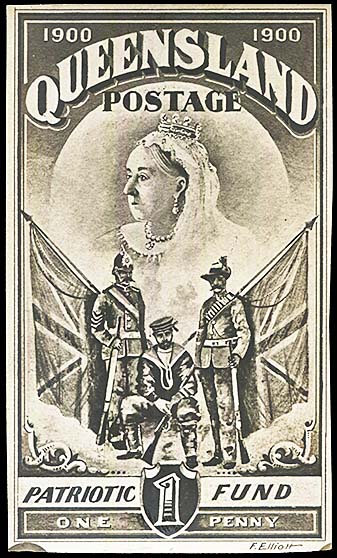 |
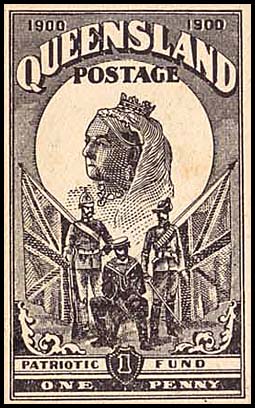 |
| 1d Essay prepared early in the design process and close to the final design. On either side at the top are the figures "1900" and beneath this "Queensland" in a Beneath this image are two Union Jacks, between which stand an Imperial Infantry Sergeant (left) a blue-jacket and a Queensland Mounted Infantryman (right). "PATRIOTIC FUND" is in italics. F. Elliott is in the lower right corner. Size of photographic essay: 52 × 89.5 mm (outer frame line). |
1d Essay prepared later during the design process. The Queen's head is placed in a white circle. The Imperial Infantry Sergeant is holding his rifle at his right side with his left hand on his left hip. The Queensland Mounted Infantryman on the right is facing to the right and he is holding a sword. "PATRIOTIC FUND" is not in italics. The above image has been extracted from Size of this essay: 24.5 × 40.5 mm (outer frame line). |
 The Artist's hand painting is in shades of violet and white on board (170 × 98 mm). It is also known as the top design in the vertical composite die proof. Only one photographic essay is recorded of this design. |
1d Essay - but the design was not adopted.
The stamp depicts the engagement of the Queensland Mounted Infantry at Sunnyside, Cape Colony in late December 1899. The Queenslanders figured very prominently. QUEENSLAND POSTAGE is coloured in an arc across the top. The subject depicted might have been chosen for one of the issued stamps if the picture was larger. It was however too big for adequate treatment on a small stamp. In addition, the design was considered to be too violent for a postage stamp design.
|
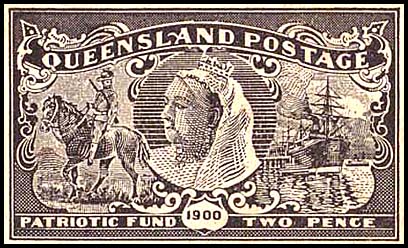 2d essay from the left of the composite zinc etched master. The Queen's head has a background of coarse lines. Her eyebrows are not clearly defined and her eyes are looking ahead. QUEENSLAND POSTAGE is in white on an unbroken scroll filled with solid black. Known as a proof on the zinc etched master as well as being a photographic essay (52 × 93 mm). This design and the next two designs were not considered to be appropriate because of the Queen looking at the rear of the horse. |
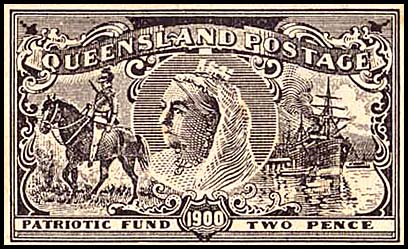 2d essay from the left of the composite zinc etched master. The Queen's head has a background of finer lines. Her eyebrows are clearly defined and her eyes are looking slightly upwards. QUEENSLAND POSTAGE is in white on a folded scroll which has vertical shading lines and coloured in shades of grey. Known as a proof on the zinc etched master as well as being a photographic essay (52 × 93 mm). |
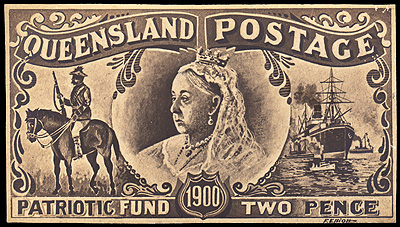 |
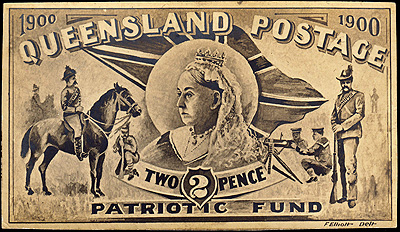 |
| 2d Essay - sometimes regarded as being the poorest of the designs.
The Queen's head is in a larger central shaded circle extending to the lower band and date shield. Her eyebrows are clearly defined and her eyes look tired. QUEENSLAND POSTAGE is in white on an solid coloured background but the scroll is divided into two parts. Known only as a photographic essay (47 × 83 mm). The side designs were interchanged and the lettering was changedto prepare the final design. |
2d Essay with unadopted images.
It shows the bust of the Queen wearing a more defined dress and no earrings. QUEENSLAND POSTAGE is in white with no scroll or background. Known only as a photographic essay (52 × 93 mm). The words "F Elliott Delt" are just outside the design in the lower right corner. Only known example and no hand printed essay recorded. |
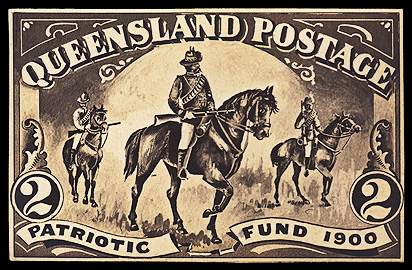 2d Essay with no image of Queen Victoria. |
It shows three mounted Colonial Queensland Infantryman all facing to the right and carrying rifles in different positions. The figures, especially the one in the foreground, were large for the stamp design. QUEENSLAND POSTAGE is in white in an arc across the top of the image. Known as a photographic essay (58 × 89 mm) |
As the designs were being developed, some zinc dies were produced to print images. Scudder is the only previous source
to have made a reference to these - mainly because the items have not been available on the market for some time
or they have not been exhibited.
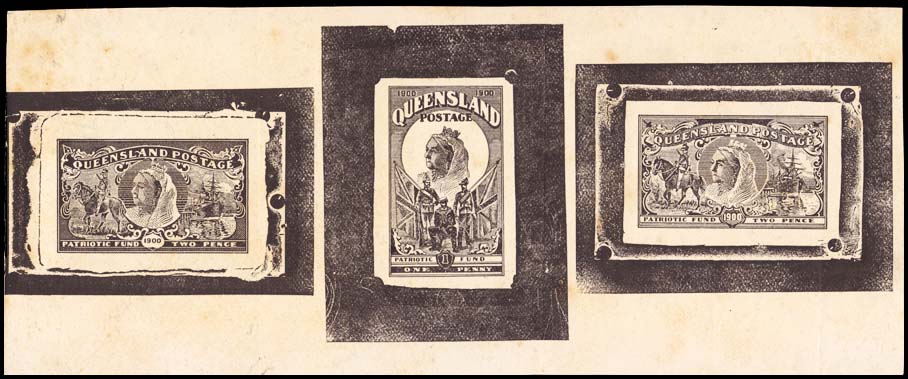 |
Essay designs based on drawings by Fred G. Elliot, the Government lithographic artist for the 1d and 2d denominations. Provenance: Alan Griffiths. |
 |
Composite essay designs based on Elliot's original drawings.
The central image is not known separately. It shows the Queen's head in side profile looking left in a white background. The flags of Great Britain and Queensland are shown on either side below the Queen. A Mounted Infantryman on his horse is underneath and between the flags. Printed on glossy card Prestige Philately 8 March 2011, Lot 736. |

